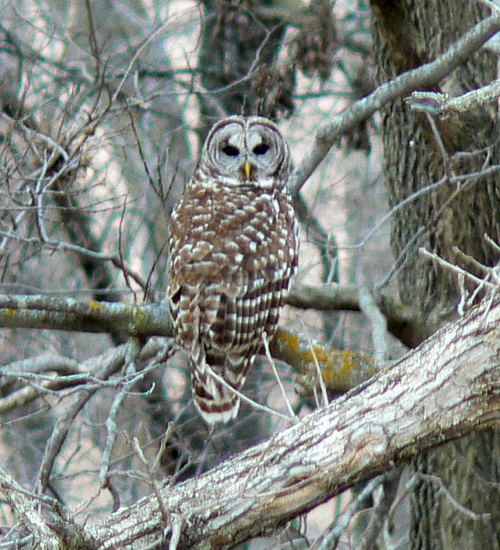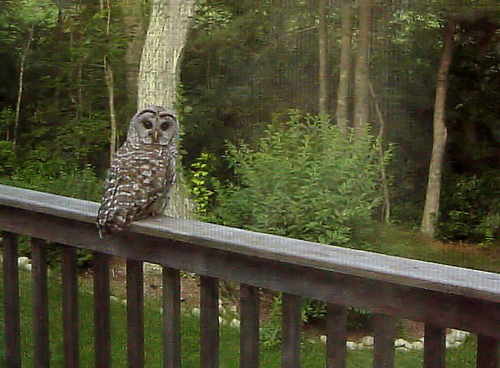Barred owls are probably the most familiar owl in the state. Their heads are round and their feathers are brown and white. The brown streaks that patten their breasts look like vertical bars and give them their name. The adults can weigh about 2 pounds and their wingspans are about 4 feet.
Owls fly very quietly. They have specially-designed, sound-absorbing feathers that allow them to accomplish silent flight. Their feathers tend to absorb high-frequency sound, and in addition the leading edges of their wing feathers have a fringe called flutings that both aid in stable flight and muffle the sound of air moving over the wing. Feathers trailing from the back of their wings mitigate sound waves produced by air flowing over the wing and off of the back.
The most commonly heard call of the barred owl is a hoot that has been described as "who cooks for you?". Click on the link under the picture for an example. You often hear a nearby owl calling to be answered by a more distant owl. Barred owls make other calls that sound like barks, whoops, shrieks or laughs. A pair of owls can really make a racket with a hoot-fest that can sound like crazed, maniacal laughter. This is often a mating duet between a male and a female in late winter. Their distinctive "who cooks for you?" hoot can be heard all through the year.
Barred owls are permanent residents across the eastern half of the US, in the nothwestern corner of the US, and in much of southern Canada. These owls are not migratory, but will move to other regions if food is in short supply.
Barred owls are very common in Connecticut.
Barred owls live along dense, mature woodlands and swamps. They are nocturnal.
Owls have excellent vision and hearing which they use to find prey. Barred owls eat small mammals up to about the size of rabbits as well as birds, reptiles, amphibians, fish and smaller owls. They tend to dive down silently on their prey and capture it with their strong, sharp talons. Barred owls swallow their prey whole. They later regurgitate undigestible parts like bones and hair in a compact lump called an owl pellet.
In Connecticut barred owls court in February and March and you are most likely to hear them calling in these months. Owls tend to mate for life, and find each other each mating season. Barred owls nest in tree cavities and usually lay 3 to 4 eggs. The eggs take about a month to hatch and both parents care for the young. Young owls begin to fly in 3 to 4 months and will be independent by fall. The lifespan of barred owls is about 18 years in the wild.

